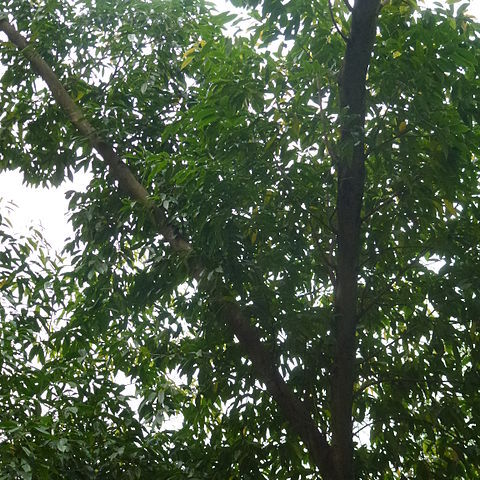Trees to 20 m tall. Bark gray-black; branchlets glabrous; terminal buds gray puberulent. Petiole black when dry, 1-2.5 cm, glabrous, swollen at upper end; leaf blade oblong, broadly elliptic, or elliptic, 9-15 × 3-4.5 cm, thinly leathery, not glandular, glabrous, lateral veins 7 or 8 per side, prominently raised abaxially, conspicuous adaxially, veinlets conspicuous on both surfaces, base cuneate, ± decurrent, margin conspicuously crenate, apex acuminate or caudate-acuminate, acumen 1.5-2 mm. Raceme 7-10 cm; peduncle pubescent. Pedicel 6-7 mm. Flowers bisexual. Sepals 5, lanceolate. Petals 5, slightly shorter than sepals, margin ciliate, laciniate. Stamens 15; anthers not awned but ciliate at apices. Disk 5-lobed, each 2-lobed again, pubescent. Ovary pubescent, (2 or)3-loculed. Drupe ovoid, 3-4 × 2-2.5 cm; exocarp inconspicuous; endocarp bony, conspicuously verrucose, 1-loculed. Seeds ca. 2 cm. Fl. Jun-Jul, fr. Jul-Sep. 2n = 30.
More
A tree. It grows about 20 m tall. The bark is grey and thin and slightly rough. The leaves are 10-15 cm long and 4-5 cm wide. They are broadly sword shaped. The base tapers. They have small teeth along the edge. The flowers are white. They are in clusters behind the leaves. These are 5-17 cm long. The fruit is fleshy with one stone. It is oval and 2-4 cm long. They are green and turn dull red.
A subtropical plant. In Nepal plants grow between 1000-1800 m altitude. In southern China it grows in forests between 2,300-2,600 m above sea level. In Yunnan.
More
Found at elevations up to 2,400 metres in the Himalayas. Open places; at elevations from 1,000-1,800 metres in Nepal.
Found at elevations up to 2,400 metres in the Himalayas. Open places; at elevations from 1,000-1,800 metres in Nepal.

